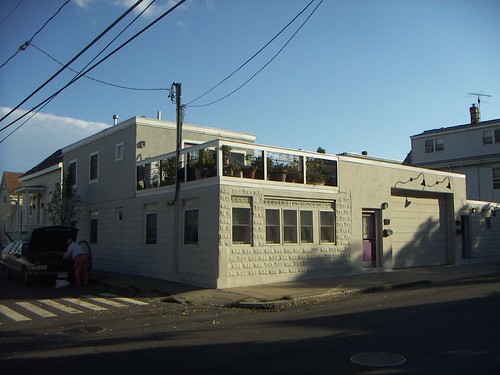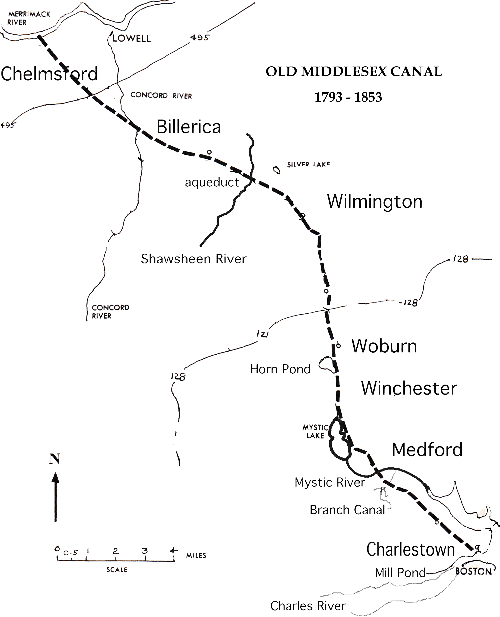The Most Tenuous of House Plans
When I engage in renovations and building geekery, people often tell me, "Bats, you should totally buy a house." I've definitely thought about it--I'll try to describe what I'd ideally like. But I have lots of reasons to hesitate--I'll also explain the reasons why I'm not rushing out to buy anything yet. A long post follows.

Part I: What I'm Looking For
Specifically, I have been collecting photos over the years that contains hints of what I'm looking for in a house; I recently collected them and posted them to Flickr.
I'd want an existing building to renovate; quite possibly something commercial or industrial, if it could be zoned for residential or live-work. Ugly and blocky? Old gas station? All good possibilities. Here are a few canonical examples.
I definitely want a substantial shop space--it's been over ten years since I've run my contractor's table saw, drill press, and bandsaw--I miss them lots. I'd want a great big garage door to move stuff in and out (possibly a loading dock--everybody needs a loading dock in their house!). However, the living space doesn't need to be that large--I'm currently splitting 900 sf with JMD, and in Canada, and my apartment in Canada was 770 sf, including the back bedroom that was just unheated tool and bicycle storage. Pemberton Street was 1100 sf, split with a roommate. All of these places were plenty roomy for me.
All of you know about my unnatural fascination with shipping containers; I might consider a neighborhood where I could use them as a garage, a back shed, or a deck without getting major complaints.
I'd want a place that was unrenovated--I don't want to undo somebody else's ideal kitchen to build mine. In fact, I could even work with a place with bare concrete walls--assuming I could figure out temporary measures to make it livable. It would let me do a complete insulation retrofit, exactly as I wanted to. I'd prefer to do a gradual renovation by accumulating items for cheap off of Craigslist and salvage yards--the odd kitchen appliance or salvaged building component here and there.
It would be definitely important to be within biking distance of work (Porter Square), preferably with a one-seat bus ride as an option during bad weather. This gives a pretty long distance radius--my current bike commute is 3 miles, so that includes most of Cambridge & Somerville. The area covered by the future Green Line Extension would probably be ideal (see previous thoughts along these lines.
One thing I have always loved is an indoor/outdoor space, such as the back deck at Pemberton Street--it has memories of many wonderful parties, dinners, and brunches.

A roof deck would work quite nicely--an example in Somerville.

When I visited the Noguchi Museum in Queens, I really loved the building--a former factory in warehouse-and-chop-shop land, filled with sculpture and artwork. But there were concrete walls all around the yard, and a Japanese garden inside--a small refuge hidden in the city.

Oh yeah--solar panels (domestic hot water, perhaps photovoltatics) when I build up enough money again to buy them.
Part II: Why I Worry About It
All this being said, I'm wondering if this type of a place is really what I want, whether I would have time to deal with it, and whether it actually is "the right time to buy."
It seems like home ownership is not really structured for single people--even typical condos are more space than I need, and condos seldom have space for a shop. I really wouldn't want more than I could look after on a regular basis, getting slogged down with maintenance constantly. To be just straight-forward realistic, I'm not envisioning myself as part of a couple anytime soon.
Most importantly, I barely have enough free time as it is--it's probably unreasonable to think that I could renovate a building in my spare time and weekends. And it's pretty likely I'll continue to spend a week at a time on the road for work. And trading off working time for free time means less money to buy the place and/or renovate it. Ugh. I'm worried that even if I do this renovation, it will take over my life, and I'll never have free time again ("Hi ho, Friday night, time to get back to hanging drywall...") Not to mention being unavailable for friends' projects.
Similarly, this great shop that I want to put together--will I have any time to use it, to create furniture and the like for myself and friends?
I know, I know--the economic argument--"By renting you're just paying somebody else's mortgage..." Well, a Wall Street Journal article from the beginning of 2007 summarizes a lot of my thoughts on the subject--"Renters Gloat Over Housing Slump". From a blog on the subject ("US Housing Crash Continues"), on why "It's A Terrible Time To Buy":
It's still much cheaper to rent than to own the same thing. Yearly rents are less than 3% of purchase price. Mortgage rates are 6.5%, so it costs more than twice as much to borrow money to buy a house than it does to rent the same kind of house. Worse, total owner costs including taxes, maintenance, and insurance are about 9%, which is three times the cost of renting.
Given my current living situation, there's a lot of truth to that. If you factor in inflation (2004 to 2007), I'm currently paying less than 2/3 of my rent back at Pemberton Street (in North Cambridge, between Porter & Davis). Going to a mortgage and having my monthly payments jump up by a factor of two or three sounds incredibly frightening to me--I might not be "building equity" in property, but in other assets instead.
There's also the aspect that even when you mortgage away your life, most folks end up spending more money on a regular basis after buying a place--i.e., pouring money into appliances, renovations, Bed Bath and Beyond runs, etc.
A lot of this hinges on whether or not this is "the right time to buy." Lots of folks are saying with the downturn in the housing market, folks should jump in. I wonder how much more instability we'll be seeing over the course of this year and the next. See the graph of mortage resets that I posted earlier. I have no problem sitting it out and seeing just how bad it gets.
To be honest, I wonder just how bad the recession (is it officially one yet?) will get. For instance, here's a telling quote just from today's Marketplace:
Despite signs of inflation, especially in grocery stores and at gas pumps, analysts say the Fed's number one worry is something else. They say the Fed fears the banking system hasn't finished unraveling in the wake of the subprime mortgage meltdown.
But back specifically on housing--this graph of house prices (Case-Schiller index) from the New York Times was a real eye-opener when I first saw it; it shows housing prices normalized for inflation from 1890 to 2006. Check out what the current housing boom looks like.

(Apologies if this is depressing to any of my friends who bought in the past few years).
One telling item: you'll note that after each of the recent booms (1970s and 1980s) that prices went down to about the same inflation-adjusted level. If the Wikipedia data on the Case-Schiller index is correct, it has only backed off to ~170 as of Q4 2007. I'm not saying that it's a law of physics that requires it to return to this level. But I remember people saying during the tech bubble, "Keep putting money into tech!--the fundamental rules have changed!" or the 1999 Atlantic Monthly article "Dow 36,000" (Has the long-running bull market been a contemporary version of tulipmania? In explaining their new theory of stock valuation, the authors argue that in fact stock prices are much too low and are destined to rise dramatically in the coming years).
Uh, nope.

Note that the Dow Jones is the right-hand axis; the left-hand axis is the S&P 500.
I know it's a long shot, but I partially worry about a serious crash of the United States economy, Countdown to a Meltdown style. It falls in line with everything I know about peak oil, this country's dependence on cheap oil to function, the rise of China and India, global climate change, the inability of large-scale US manufacturing to compete on a world market, and the way that the Iraq War and tax cuts are putting this country deep into major debt.
On the flip side, it's not like I've shifted my portfolio to prepare for a major economic downturn. Where should I put my assets anyway--cash? FDIC-insured savings? Gold? Ammunition, canned goods, and a biofuel reactor?
Finally, by committing to buying a place and a mortgage, it removes any illusion I can just up and leave, drop out of the world, and not have an income for a while. That feeling comes and goes, but there are times when it seems like that might be coming.





























